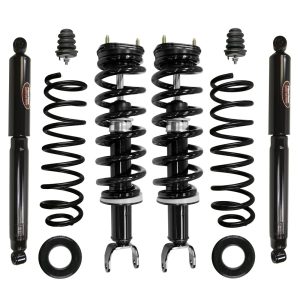Suspension systems rely heavily on springs for ride comfort, load handling, and vehicle stability. While traditional coil or leaf springs have been the mainstay for decades, air springs (airbags) offer a versatile modern alternative. This article compares both systems, delving into advantages, disadvantages, and ideal use cases—with clear tables and tips to help you decide.
And if you’re ready to upgrade, you can Buy Springs & Components online from a trusted supplier.
What Are Air Springs and Traditional Springs?

Air Springs
These use flexible rubber bladders inflated with compressed air. Mounted between the chassis and axle or suspension arm, they support the vehicle much like a pneumatic mattress.
Traditional Springs
-
Coil springs: Helical steel coils commonly found in passenger vehicles.
-
Leaf springs: Layered metal strips used in trucks, vans, and older vehicles.
They store and release mechanical energy through steel elasticity.
Key Comparison Table: Air vs. Traditional Springs
| Feature | Air Springs | Traditional Springs |
|---|---|---|
| Ride Comfort | Adjustable firmness; smooth and cushioned | Fixed spring rate; may feel harsh |
| Load-Leveling | Automatic adjustment for varied loads | Sag under heavy load |
| Adjustability | Height and stiffness tuned via onboard control | One-size-fits-all functionality |
| Complexity & Cost | More complex; higher cost | Simple, durable, affordable |
| Maintenance Needs | Airlines & valves require monitoring | Low-maintenance; springs rarely fail |
| Cold-Weather Performance | Pressure drops require compensation | Unaffected by temperature |
| Reliability | Vulnerable to leaks and compressor issues | Robust, long-lasting |
Pros & Cons of Air Springs
Pros
-
Adjustable ride height: Ideal for towing, loading, or varying terrain.
-
Enhanced comfort: Absorbs road imperfections better than steel springs.
-
Consistent handling: Maintains vehicle stance under load.
Cons
-
Higher upfront cost: Requires air compressors, sensors, and valves.
-
Maintenance demands: Needs regular inspection for leaks and pressure levels.
-
Temperature sensitivity: Air pressure decreases in extreme cold.
Pros & Cons of Traditional Springs
Pros
-
Cost-effective: Inexpensive to produce, install, and maintain.
-
Durable: Steel springs rarely fail under normal use.
-
Simplicity: No electronics or pressure systems involved.
Cons
-
Fixed ride quality: Cannot adapt to different loads or conditions.
-
Limited load capacity: Heavier loads cause sagging and reduced control.
-
Harsh response: Less effective at dampening large bumps.
When to Use Which?
| Scenario | Recommended Spring Type | Why |
|---|---|---|
| Daily driving, light loads | Traditional coils | Comfortable, cost-effective solution |
| Varying cargo weights/towing | Air springs | Maintains ride height under load |
| Off-roading or RV use | Air springs | Tunable firmness, improves ground clearance |
| Performance or sports driving | Stiffer coil/adjustable air | Better handling and reduced body roll |
| Fleet vehicles & delivery vans | Air suspension | Maintains level ride under heavy fatigue loads |
| Budget builds/restorations | Leaf or coil springs | Affordable and simple to maintain |
Maintenance and Tips
Air Spring Care:
-
Inspect for leaks regularly — listen for hisses or feel using soap solution.
-
Ensure compressor works properly — key for maintaining correct ride height.
-
Winterize by adding a moisture separator to prevent freezing.
Traditional Spring Maintenance:
-
Check for cracks or rust — especially on coils and leaf packers.
-
Address sag early — replace springs before axle droops excessively.
-
Pair replacements in sets (front/rear) to preserve ride balance.
Cost and Installation Overview
| Component/Service | Typical Cost Range |
|---|---|
| Air spring kit (per axle) | €400–€800 |
| Compressor & management | €200–€600 |
| Coil spring set | €100–€300 |
| Leaf spring replacement | €150–€400 per axle |
| Professional install | €200–€500 |
While air systems may double the initial cost, they deliver long-term savings by enhancing comfort, reducing frame wear, and improving load control.
Final Thoughts

-
Opt for air springs if you tow heavy loads, require ride height control, or demand adaptable performance.
-
Stick to traditional steel springs for everyday driving, budget builds, or vehicles where simplicity and durability matter most.
Whether you choose coils, leaf packs, or airbags, proper selection and maintenance ensure optimal ride quality, longevity, and performance.
Upgrade your ride philosophy — Buy Springs & Components online today to match your vehicle demands and driving conditions.